
94% of researchers rate our articles as excellent or good
Learn more about the work of our research integrity team to safeguard the quality of each article we publish.
Find out more
ORIGINAL RESEARCH article
Front. Endocrinol. , 25 January 2023
Sec. Clinical Diabetes
Volume 14 - 2023 | https://doi.org/10.3389/fendo.2023.1124027
This article is part of the Research Topic Advanced Approaches in the Diagnosis and Treatment of Diabetes Mellitus and Secondary Complications View all 46 articles
Background: Nanomaterials have recently been shown to have a considerable advantage in promoting wound healing in diabetic patients or animal models. However, no bibliometric analysis has been conducted to evaluate global scientific production. Herein, this study aimed to summarize the current characteristics, explore research trends, and clarify the direction of nanomaterials and diabetic wound healing in the future.
Methods: Relevant publications from 2011 to 2021 were collected from the Web of Science Core Collection on October 3, 2022. VOSviewer, CiteSpace, bibliometrix-R package, Origin 2021, and Microsoft Excel 2019 were used for bibliometric and visualization analyses.
Results: We identified 409 publications relating to nanomaterials and diabetic wound healing. The number of annual productions remarkably increased from 2011 to 2021, with China and Shanghai Jiao Tong University being the most productive. The most prolific authors were Hasan Anwarul. The leading journal was the International Journal of Biological Macromolecules, with 22 publications. The most popular keywords were “nanoparticles,” “delivery,” “in vitro,” “electrospinning,” “angiogenesis,” and “antibacterial.” Keyword burst analysis showed “cerium oxide,” “matrix metalloproteinase 9,” “composite nanofiber,” “hif 1 alpha,” and “oxide nanoparticle” were emerging research hotspots.
Conclusion: We found there has been a great progress in the application of nanomaterials in diabetic wound healing from 2011 to 2021. Although many researchers and institutions from different countries or regions contributed contributed to publications, it will be helpful or the development of this field if the degree of international cooperation can be enhanced. In the future, nanomaterials with powerful antioxidant and antibacterial qualities and promoting angiogenesis are the research hotspots.
Diabetes mellitus (DM) is the most prevalent chronic metabolic disease characterized by hyperglycemia due to insulin deficiency or insulin resistance (1). The 10th edition IDF Diabetes Atlas estimated that approximately 537 million individuals live with diabetes worldwide (2). China has the highest number of patients with diabetes, which may reach over 174 million by 2045 (3). Besides sustained hyperglycemia, various complications occur, including diabetic ulcers, diabetic cardiomyopathy, and diabetic nephropathy. Diabetic foot ulcers (DFU) or diabetic non-healing wounds are catastrophic complications, which put a great social and economic burden on patients and the healthcare system (4). DFU affects 19%–34% of patients with DM, leading to 15%–25% of amputations and increasing the five-year death rate to 80% (5–7). A seven-year single-center retrospective review reported that the average total cost per patient was ¥21,826.91 ($3089.14) (8).
Normal wound healing consists of four successive and overlapping stages: hemostasis, inflammation, proliferation, and remodeling, which involve many types of cells and cytokines (9). However, diabetic wound healing usually does not progress due to the complex microenvironment with hyperglycemia, hypoxia, poor angiogenesis, and bacterial infection (10). Conventional treatment, including debridement, dressing, wound off-loading, infection control, vascular assessment, and glycemic control were ineffective, with 14%–20% of patients eventually undergoing low limb amputations (11, 12). Development of new treatments, such as nanotechnology, are urgently needed to improve patients’ quality of life. Recently, many studies have been performed to verify that nanomaterials with different biological characteristics can get encouraging results in diabetic wound healing (13–15). Some nanomaterial-based wound dressings, such as hydrogels and nanofibers, provide a wet atmosphere by imitating the extracellular matrix for wound healing and enable the cell migration and proliferation by loading some drugs, protein and cytockines; Some nanomaterials, such as bioglass nanoparticles and metal nanoparticles, are of great angiogenic and antibacterial activities to improve the antibacterial effect and reduce the abuse of antibiotics by acting as the smart delivery system (16–18). Currently, several reviews have discussed the advances in the link between nanomaterials and diabetic wound healing, but comprehensive evaluation of the research status in this field is challenging.
Bibliometrics is an interdisciplinary subject that can be applied to conduct quantitative and qualitative analyses of publications by using mathematical and statistical methods (19). It includes the contributions and influence of different authors, countries/regions, institutions, journals, and trends (20). To the best of our knowledge, no bibliometric analysis has summarized current research hotspots. This study aimed to examine publication trends in nanomaterials and diabetic wound healing from 2011 to 2021 and provide future research direction for new researchers via the Web of Science Core Collection (WoSCC).
We collected publication data and downloaded them as plain text from WoSCC on October 3, 2022. Data included the article title, authors, journal title, publication year, institutions, keywords, citation frequency, and other basic information. Figure 1 shows data acquisition and retrieval strategies.
The accuracy of data must be ensured for analysis. Two researchers independently retrieved literature, and disagreements were resolved by discussing with outside parties, if necessary.
(1) The research topic should be the application of nanomaterials in diabetic ulcers or diabetic wounds. (2) The document type is an article or a review article. (3) The document language is limited to English. (4) The study was published from January 1, 2011, to December 31, 2021.
(1) Irrelevant documents, (2) other chronic wounds, such as burns, lower extremity venous ulcers, pressure ulcers, and diabetic corneal wounds, (3) retraction, (4) lack of basic information required for bibliometric analysis.
CiteSpace is Java-based bibliometric software, a widely used tool for the visual exploration of scientific literature, and helps discover research hotspots and future trends (21). We used CiteSpace (6.1.4) to perform dual-map overlay of journals, produce clustering analysis of keywords and co-cited references by using the log-likelihood ratio (LLR) algorithm, create a timeline view of keywords and co-cited references, and conduct keywords and co-cited references with the strongest burst.
In 2009, Van Eck and Waltman of The Centre for Science and Technology Studies at Leiden University in the Netherlands developed VOSviewer, a Java-based free software (22). VOSviewer (1.6.18) was used to visualize the co-citation network of countries, institutions, and authors. In the visual map, the node size indicated numbers or frequency, and the line thickness represented the strength of the link.
The bibliometrix R package (https://www.bibliometrix.org) was used to generate the distribution map of global publications. Microsoft Excel 2019 and Origin 2021 were used to display annual publications produced, international links of countries, and changes in yearly volume in China, India, and the USA.
We included 409 documents meeting the inclusion and exclusion criteria from the Web of Science database in our bibliometric analysis. Figure 2A shows the annual production of publications. Only a few articles were published in this field. Despite only five papers published in 2011, the number increased to 121 in 2021, with an increase of 2330%. Two phases were observed in the growth of literature published in the last decade: slow growth from 2011 to 2015, followed by rapid growth from 2016 to 2021. Carrot2 is an application for text clustering algorithms and organizing search results into topics. We divided 409 documents into 57 theme clusters for the Carrot2 analysis. We found that the top topics were “controlled release,” “bacterial wound,” “promoting angiogenesis,” “nanoparticles promote,” and “diabetic wound therapy” (Figure 2B).
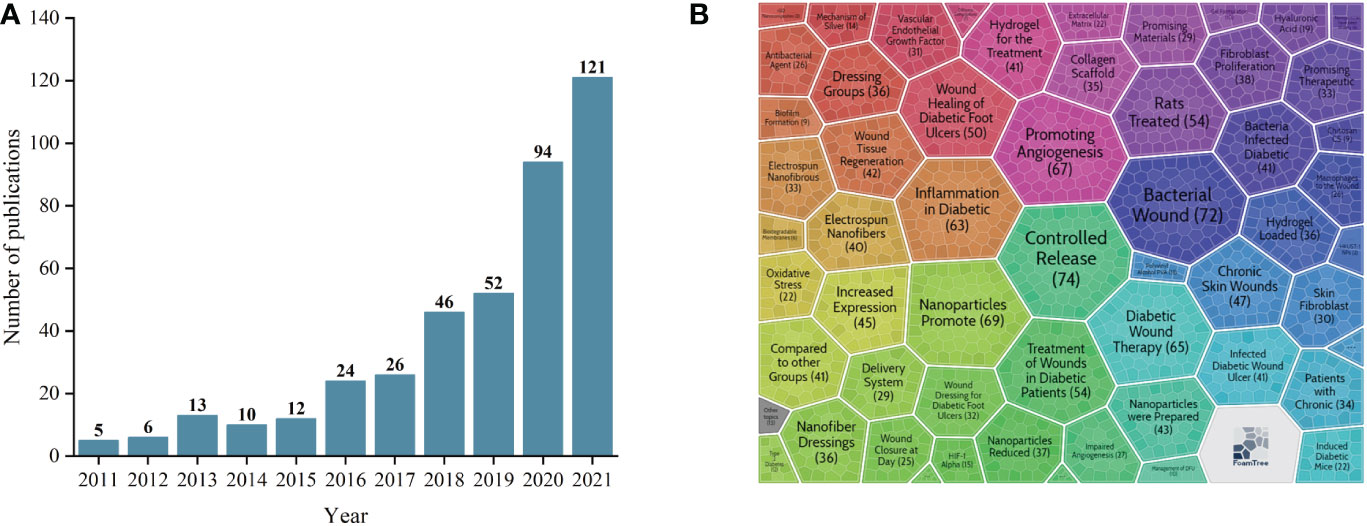
Figure 2 Annual number of publications (A) and theme clusters for the nanomaterials in diabetic non-healing wound by Carrot2 (B).
Fifty-one countries or regions contributed to publications in nanomaterials and diabetic wound healing. The distribution of published documents was shown on a world map, with the blue intensity representing the total number of publications (Figure 3). Figure 4A and Table 1 show that China published the most number of papers (n = 167, 40.83%), followed by India (n = 48, 11.74%), the USA (n = 32, 7.82%), Iran (n = 21, 5.13%), South Korea (n = 21, 5.13%), Egypt (n = 14, 3.42%), and Malaysia (n = 14, 4.42%). Other countries or regions published no more than five papers. In 2018, China’s annual publication volume was significantly higher than that of India and the USA (Figure 4B). Among the top 10 countries, China also had the highest number of single-country papers, whereas the ratio of multiple-country papers ranked behind the USA and Brazil (Table 1). Moreover, the number of publications in China was significantly higher than that in other countries.
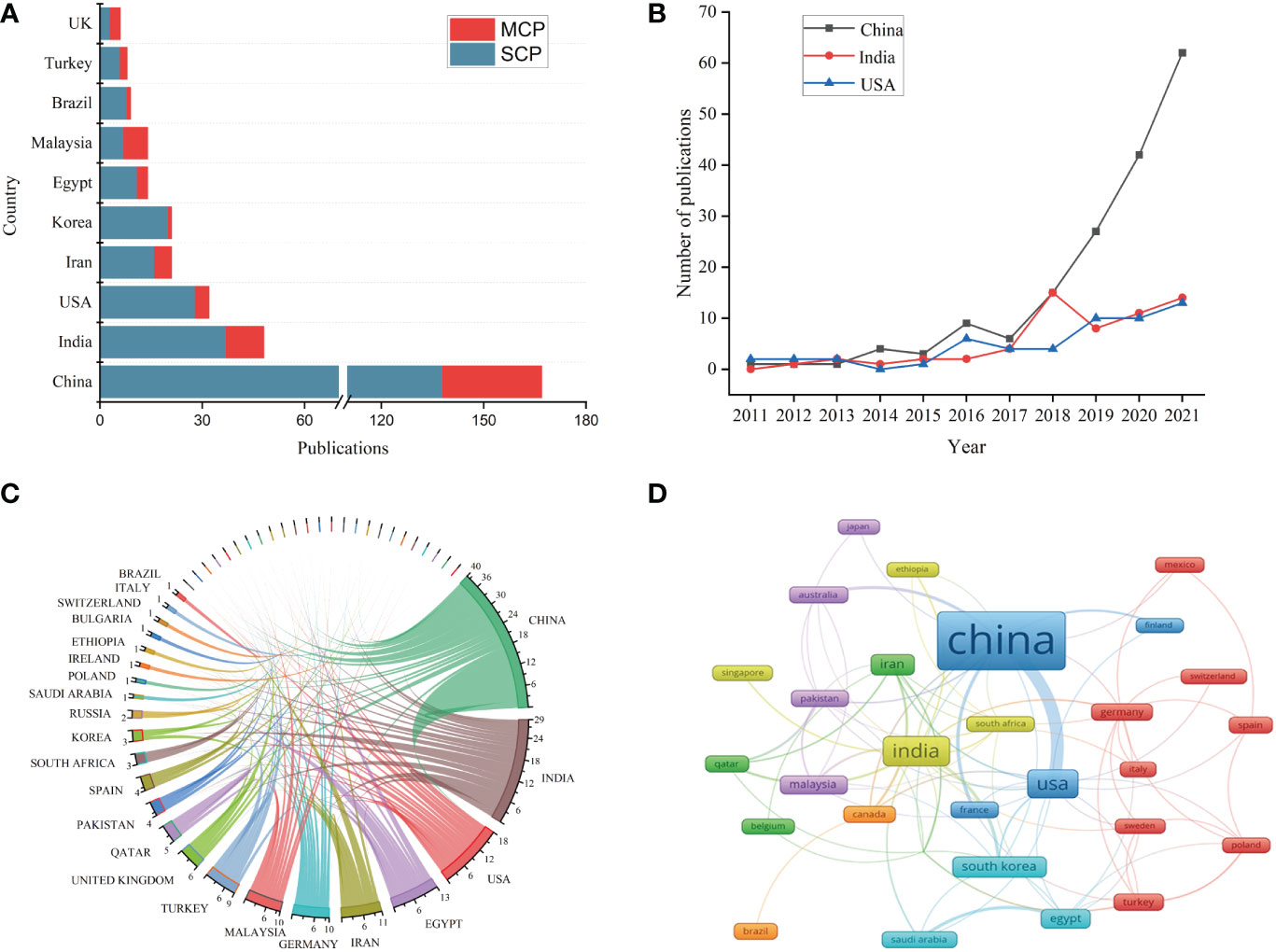
Figure 4 The distribution of single or multiple country papers in top 10 countries (A); annual number of publications in China, India and USA (B); The international cooperation networks between countries/regions (C); VOSviewer network map of countries/regions (D).
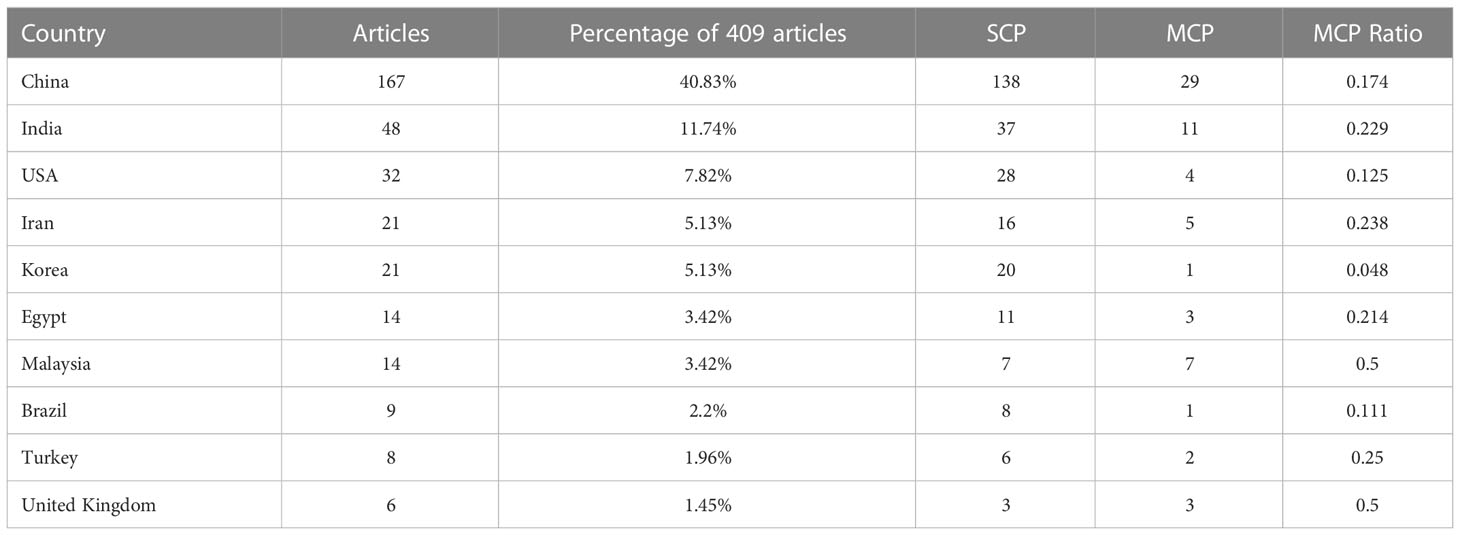
Table 1 Total number of publications, single country publications, and multiple country publications of top 20 Countries by corresponding authors.
Figures 4C, D shows countries or regions with co-occurrence network. The size of the nodes represented the number of papers, and the line thickness showed cooperation strength. Of 51 countries, China and the USA had the strongest links. Accordingly, China was the most influential in the field based on publications and centrality.
In the field of nanomaterials and diabetic wound healing, 699 institutions published 409 articles. Table 2 shows the top ten contributing institutions. Shanghai Jiao Tong University published the most papers (n = 17), followed by the Chinese Academy of Sciences (n = 16), Shanghai Normal University (n = 10), Sichuan University (n = 10), and Tehran University of Medical Sciences (n = 10). Other institutions published fewer than ten articles. Of the top ten institutions, eight were from China, and the remaining were from Iran and Qatar.
We used VOSviewer to demonstrate the co-authorship network of institutions (Figure 5). The minimum number of articles published by the institution was set to 5, and 13 clusters consisting of 27 institutions met the thresholds. Some of the 27 institutions were connected with others, with the largest set of connected clusters consisting of 11 institutions, of which Shanghai Jiao Tong University, Chinese Academy of Science, and Shanghai Normal University were the core. Research institutions in China were the leading organizations in nanomaterials and diabetic wound healing.
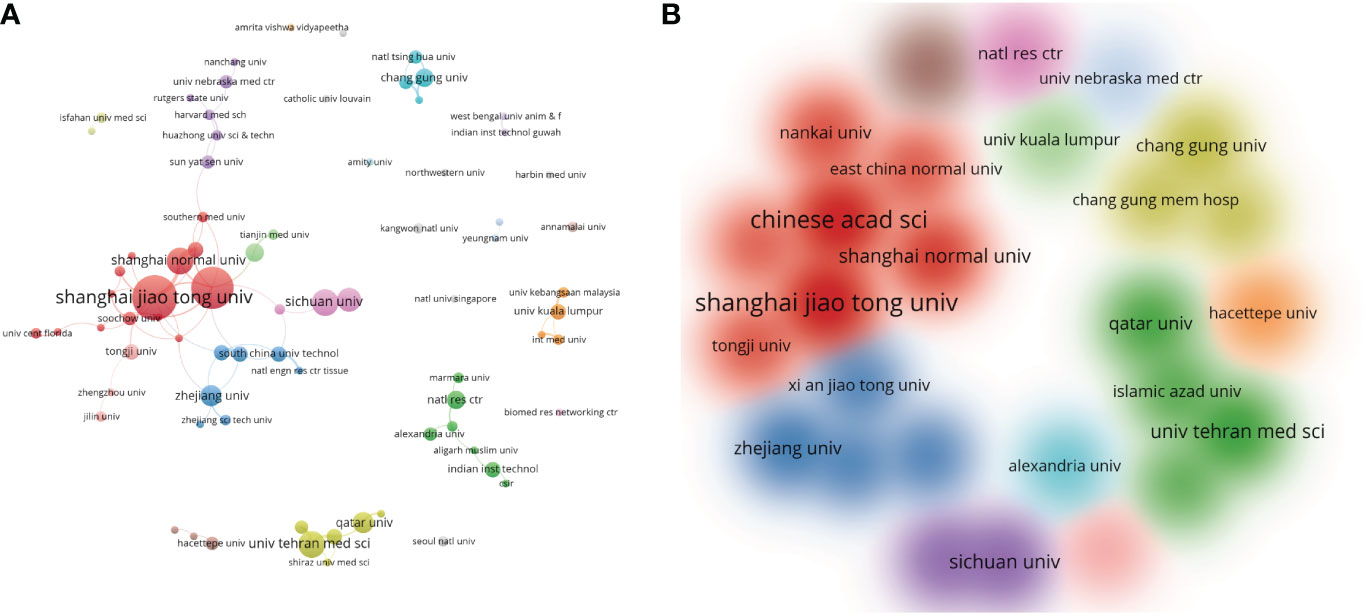
Figure 5 VOSviewer network map of institutions (A); Density distribution map of institutions (B). Minimum number of articles published by the institution was set to 5.
We retrieved 409 articles with 2508 authors, with an average of 6 authors per article. Table 3 lists 13 of the most effective authors. Xu He and Hasan Anwarul were the most prolific scholars, with 8 papers each, followed by Ke Qinfei (n = 7). In terms of total citations, Hasan Anwarul ranked first with 569 citations, followed by Jayakumar (n = 402) and Augustine Robin (n = 401). Although Xu He and Hasan Anwarul had the same number of publications, the average citations per paper of Hasan Anwarul (71.13 times) were significantly higher than those of Xu He (40.88 times).
H-index, g-index, and m-index were used to evaluate the academic level and influence of researchers, indicating that Hasan Anwarul made great achievements in nanomaterials and diabetic wound healing-related studies. VOSviewer was used to perform a visual analysis of the co-author (Figure 6). The minimum number of articles published by the author was set to 4. The largest clusters of connected authors consisted of six authors, and four of them were in the top 13.
These articles on nanomaterials and diabetic wound healing were published in 161 journals. Table 4 lists the top 15 journals with the most articles published, accounting for 38.14% (156/409). The International Journal of Biological Macromolecules, with 250 articles published, was the most productive journal, followed by Materials Science & Engineering C-Materials for Biological Applications currently known as Biomaterials Advances (n = 16, IF = 8.457), Acta Biomaterialia (n = 14, IF = 10.634). Based on the co-citation count, the International Journal of Biological Macromolecules (1217 citations), Acta Biomaterialia (871 citations), Biomaterials (581 citations), and Materials Science & Engineering C-Materials for Biological Applications (560 citations) were the top four journals. The others had <500 citations. Besides, 9 of 15 were found in the first quartile (Q1), and four had an IF impact of >10.
Citespace was used to show the topic distribution of relationships between journals by using the dual-map overlay. Figure 7 shows that the citing and cited journals are found on the left and right, respectively, and the colored line path represents the citation relationship, indicating the citation trajectory and knowledge flow. The map showed that molecular/biology/immunology journals generally cited articles published in molecular/biology/genetics and chemistry/materials/physics journals. The two pink routes showed that articles published in physics/materials/chemistry journals often cited molecular/biology/genetics journals and chemistry/materials/physics journals, indicating that articles on nanomaterials for diabetic wound healing mainly focused on journals in molecular, biology, immunology, and physics, materials, and chemistry.
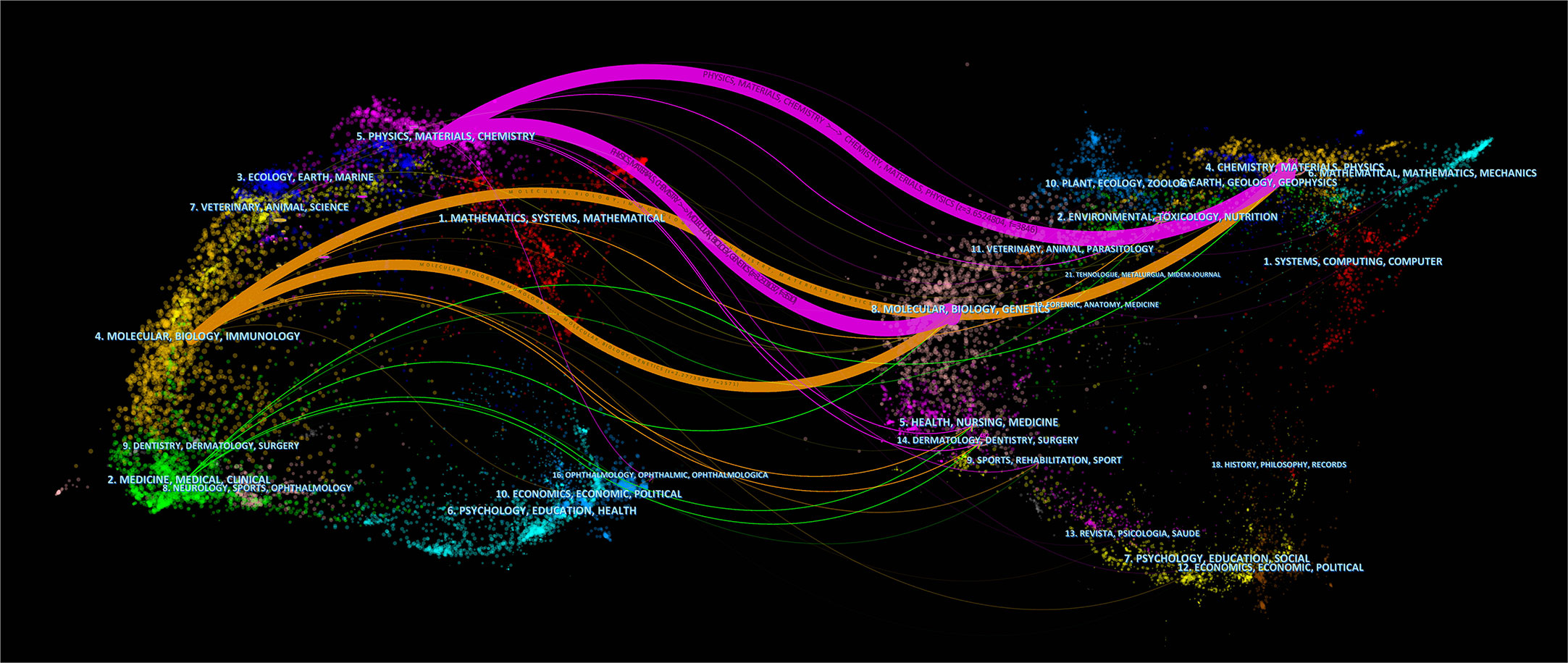
Figure 7 The dual-map overlay of journals contributed to publications regarding nanomaterials for diabetic wound healing from 2011 to 2021.
The research hotspot in a certain knowledge field can be identified through keyword analysis. Subsequently, 1918 keywords were extracted from 409 selected articles, approximately 4.6 keywords per article. Of these, 172 keywords appeared over 5 times. After removing basic search terms, such as “wounds” and “diabetes,” bibliometrics was used to create a word cloud map for keywords plus and author keywords (Figures 8A, B). “Electrospinning,” “angiogenesis,” “antibacterial,” “nanoparticles,” “drug-delivery,” and “wound dressing” were common research hotspots in nanomaterials and diabetic ulcer healing.
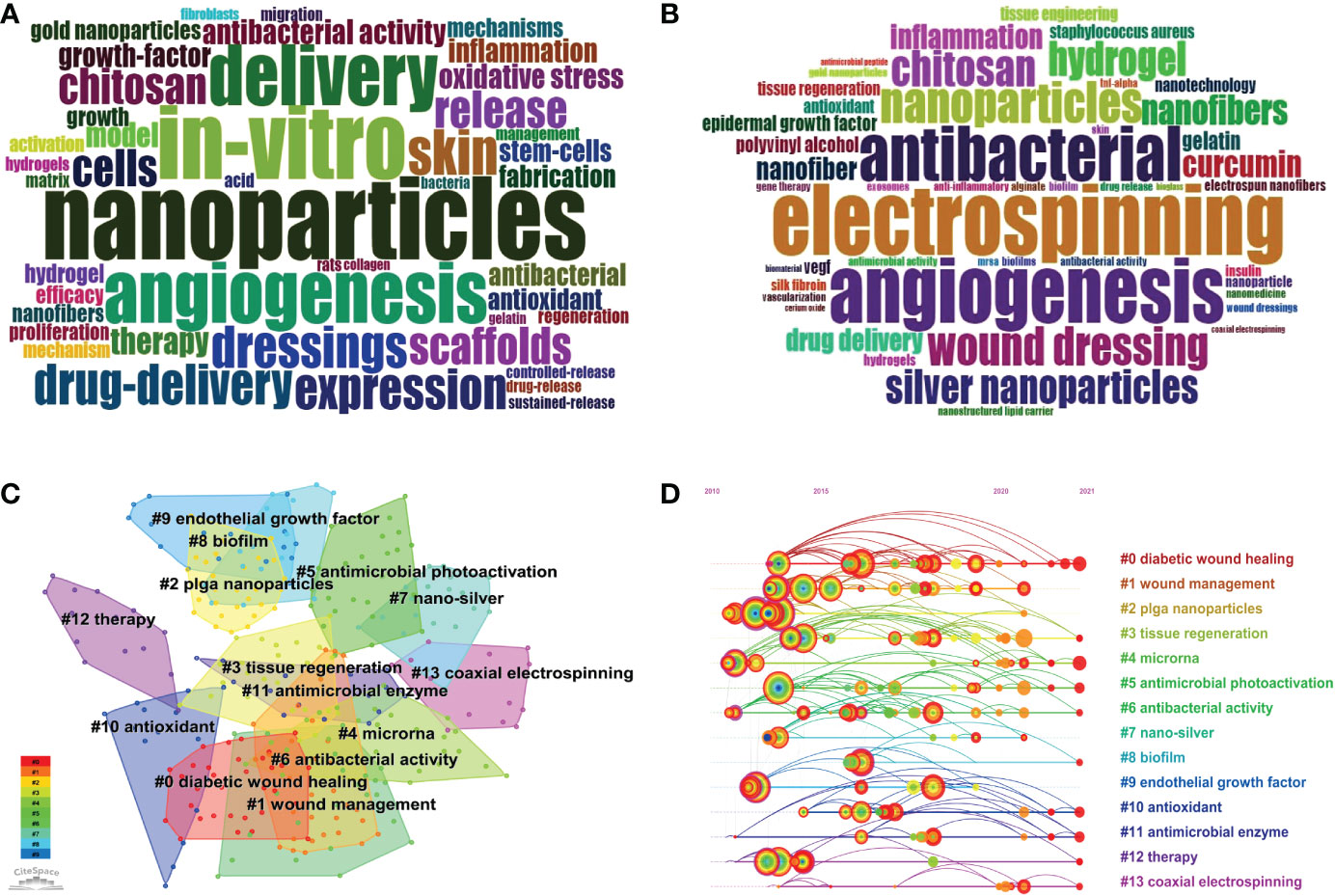
Figure 8 Word cloud of top 50 plus keywords (A); Word cloud of top 50 author’s keywords (B); Map of keyword clusters (C); Timeline view of keyword co-occurrence (D).
In terms of keyword co-occurrence, CiteSpace software was used to perform keyword clusters by using the LLR algorithm. We selected the first 14 cluster labels (#0–#13) for analysis. The 14 clusters focused on 3 aspects: (1) diabetic wound healing process, including clusters #0, #1, #3, #4, #9, and #12; (2) nano-sized nanomaterials, including clusters #2, #7and #13; (3) mechanism of nanomaterials promoting diabetic wound healing, including clusters #5, #6, #8, #10 and #11.
The clustering time map can further show the appearance of each cluster. The end and time trends can reflect the importance, degree, and distribution period of a cluster. We found that cluster #9 stopped evolving since 2019. Although cluster #8 appeared the latest, it continued to evolve recently. In addition, clusters #5, #6, #10, and #11 maintained a certain heat recently, indicating that the mechanism of nanomaterials in treating diabetic wounds is the current research trend. Moreover, keyword bursts were used to show research trends in the field. Figure 9 shows the top 30 most cited keywords. The keyword with the highest burst intensity was “silver” (2.8357), followed by “collagen” (2.7329) and “nanocomposite” (2.6773). The keyword with the longest duration was “regeneration”, followed by “fibrous scaffold”, “Staphylococcus aureus”, “matrix metalloproteinase”,”curcumin”, “collagen”, and “proliferation.”
Citations are the standard way for authors to indicate the source, ideas, and findings of their research methods. The citation frequency of an article can measure its value to a certain extent. Table 5 shows the top 10 globally cited articles (23–32). “Engineering Bioactive Self-Healing Antibacterial Exosomes Hydrogel for Promoting Chronic Diabetic Wound Healing and Complete Skin Regeneration” published in Theranostics in 2019 had the largest number of citations (289 times).
Reference co-citations can be used to measure the degree of mutual influence among studies, among which the highly cited studies form the disciplinary basis of this field. Table 6 lists the top 10 co-cited references (26, 33–41). The most co-cited reference was “Wound healing and its impairment in the diabetic foot” by Falanga et al. in 200530. All references were clustered into the major 16 clusters, including “#0 diabetic foot ulcer”, “#1 EGF,” “#2 diabetic wound healing,” and “#3 silver nanoparticle,” and so on (Figure 10A). Figure 10B shows that “#11 nanofibers” and “#13 antibacterial properties” continuously evolved.
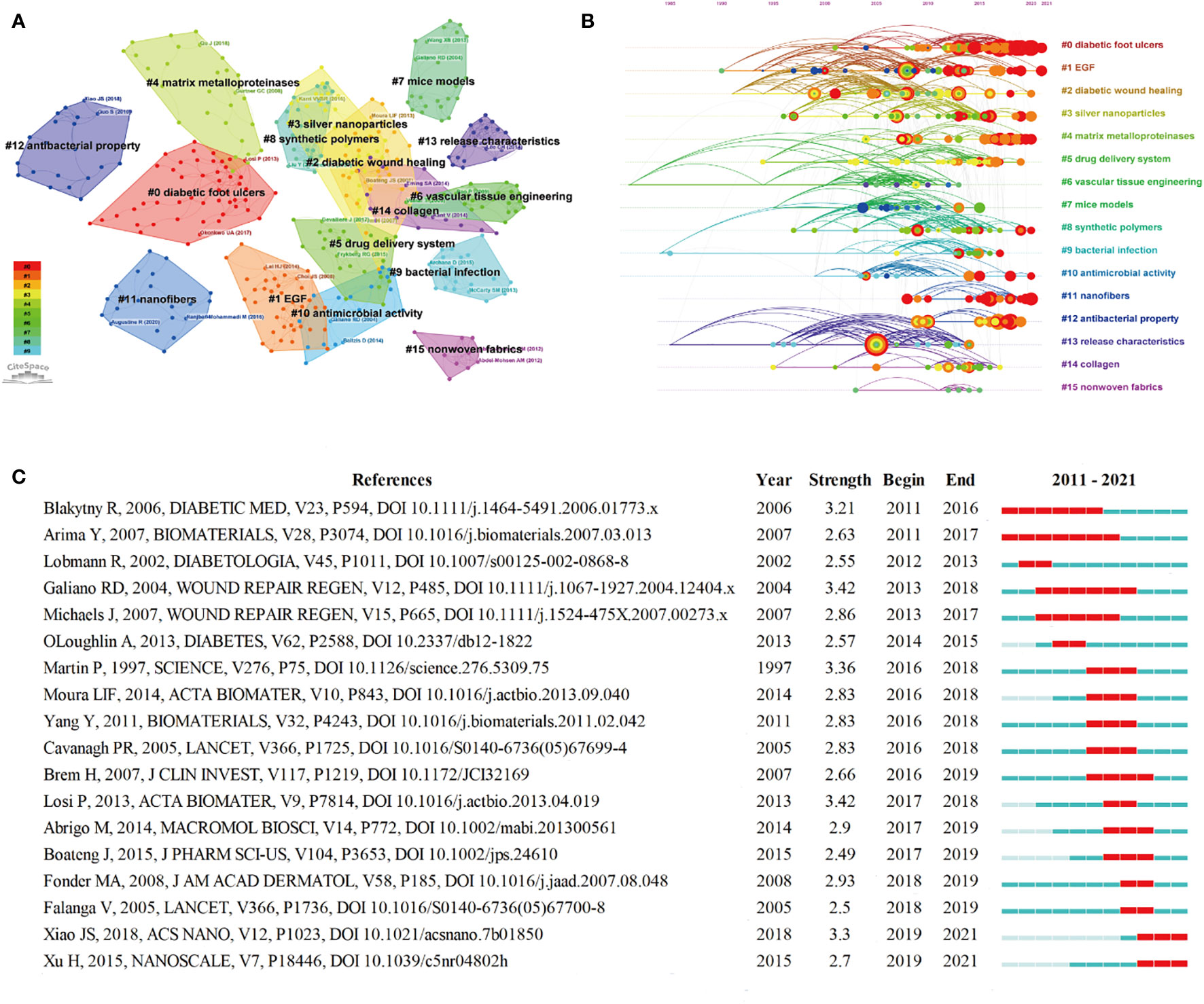
Figure 10 Map of cited references clusters (A); Timeline view of cited references co-occurrence (B); Top 18 references with the strongest citation bursts (C).
Figure 10C shows the top 18 references with the strongest citation bursts. “Fibrin-based scaffold incorporating VEGF- and bFGF-loaded nanoparticles stimulate wound healing in diabetic mice” by Losi et al. in 2013, and “Quantitative and reproducible murine model of excisional wound healing” by Galiano et al. in 2004 had the strongest burst (3.42) (26, 42). Additionally, the article “Effect of wettability and surface functional groups on protein adsorption and cell adhesion using well-defined mixed self-assembled monolayers” by Arima et al. had the longest burst period from 2011 to 2017 (43).
Non-healing diabetic wounds, resulting in high mortality rates and disability in diabetic patients, have become a global public health problem. Over the past years, many studies on the applications of nanomaterials in diabetic wound healing have been conducted to confirm that nanomaterials are effective pathways in treatment. Bibliometrics help researchers make comprehensive cognition in the field. For the first time, different bibliometrics software were combined to sort out the current characteristics and predict the development trends of nanomaterials and diabetic wound healing.
The number of publications reflect the scientific activities in a field. Based on our study, 2508 authors from 699 institutions in 51 countries or regions have contributed 409 publications to the field of nanomaterials and diabetic wound healing from 2011 to 2021. Moreover, the global volume markedly increased. The number of annual output is almost twice as high as that in the previous year, indicating a promising prospect in the research regarding the application of nanomaterials in diabetic wound healing.
China is the most productive country, with 167 articles in terms of country publication volume. Compared with China, publications from other countries significantly decreased. China and the USA have the closest collaboration, indicating that China is the core country for international research on nanomaterials and diabetic wound healing. In addition, India has the highest MCP ratio in the top three productive countries. Moreover, India plays an important role in international cooperation. As the two most populous countries in the world, China and India have the highest number of diabetic patients. Thus, scholars are driven to explore the application of nanomaterials in diabetic non-healing wounds.
Furthermore, 699 institutions contributed articles to the application of nanomaterials in diabetic wound healing. The most prolific institution was Shanghai Jiao Tong University from China which published nine papers in 2021. Figure 6 shows that institutions in close geographical proximity usually collaborated actively. For example, no cooperation was found between Shanghai Jiao Tong University and Univ Tehran Med Sci, although they were ranked at the top. Regarding the author’s contribution, Chinese scholars still played the lead role in publishing articles in the field. Table 3 shows that the most prolific authors were Hasan Anwarul. The latest article by Hasan Anwarul indicated that EGF-loaded PHBV-Gel MA hybrid patches could accelerate wound healing in diabetic mice by promoting the migration and proliferation of multiple cell types and angiogenesis (44). Similar to the status of the institutions’ links, many cooperating groups exist among several scholars. To develop this field, institutions and researchers should focus on similar research topics to establish closer cooperation.
Keyword evolution and cited references map the dynamic changes in research hotspots. Therefore, we conducted multiple visualization knowledge mapping, including cluster analysis, timeline view, and citation bursts of the references and keywords. Analysis of keywords and co-cited references showed that nanomaterials, such as oxide nanoparticles with antibacterial and antioxidant qualities and promoting angiogenesis, are encouraging trends.
Nanotechnology is an emerging field in treating diabetic complications. Nano-sized materials, such as nanoparticles, liposomes, nanofibers, and hydrogel, have an advantage in delivering drugs, providing sustained release, prolonging action time, and reducing side effects (45, 46). Nanomaterials are ideal carriers for enhancing drug delivery efficiency and cell regeneration. Researchers showed great interest in these topics from 2011 to 2015. Figure 9 shows that “fibrous scaffold,” “nanocrystalline silver,” and “nanoparticle” appeared in the earliest burst keywords, as well as “migration” and “regeneration,” which are important terms in progress in wound healing. Table 6 lists the top ten co-cited references. Most were reviews and aimed to outline the physiological and pathological processes of wound healing and summarize the negative factors that delay wound healing. Two original studies in the top ten co-cited references developed suitable carriers to deliver drugs or cytokines, such as EGF, VEGF, and bFGF (26, 36).
In addition, nanomaterials with antibacterial, anti-inflammatory, and antioxidant properties are another main reason for their application in improving diabetic wound healing. Figures 8C, D, 10A, B show that antibacterial or antimicrobial is the most important cluster that continuously evolves in diabetic wound healing. Besides, the ongoing burst keywords included “oxide nanoparticle,” “hif 1 alpha,” and “cerium oxide” which reflected the latest research trends. HIFP-1α is an important factor in diabetic wound healing, and the degradation of polyubiquitinated HIF-1α diminishes wound healing efficacy. Therefore, it is an effective treatment to stabilize the HIF-1α protein. Yang et al. designed an intelligent NIR-triggered NO nanogenerator to increase HIF-1α expression to enhance angiogenesis (47). Leung et al. also Introduced a small-molecule HIF-1α stabilizer to accelerate diabetic wound healing by enhancing angiogenesis (48). Metals and their ions were beneficial to wound care. With the development of nanotechnology, metal oxide nanoparticles have attracted the interest of researchers. Cerium oxide nanoparticles were widely used in diabetic non-healing wounds because of their antioxidant properties. Augustine et al. designed a type of cerium oxide nanoparticle-loaded gelatin methacryloyl hydrogel to accelerate wound healing in diabetic mice (49). Dewberry et al. and Stager et al. also used cerium oxide nanoparticles as raw material in preparing a nanocarrier to promote diabetic wound healing (50, 51). Some metal oxide nanoparticles were utilized because of their antibacterial properties. Wang et al. developed a nanocomposite scaffold composed of iron oxide nanoparticles and showed antioxidant and substantial antibacterial properties in an in vitro study (52). Nanocomposites, including zinc oxide and magnesium oxide, seem to promote wound healing through their antibacterial activity (53, 54). Thus, developing materials with powerful antioxidant and antibacterial activities is challenging for researchers.
To the best of our knowledge, this is the first bibliometric analysis that investigated the application of nanomaterials in diabetic non-healing wounds. A comprehensive survey and analysis of countries, authors, keywords, journals, and literature was conducted. Bibliometric networks through authors, institutions, co-citation, and co-occurrence analyses were constructed using various scientific tools to reveal the bibliometric characteristics of the field. Moreover, the degree of international cooperation should be enhanced to develop this field. Nanomaterials with antibacterial and antioxidant qualities and promoting angiogenesis are the current research topics.
The original contributions presented in the study are included in the article/supplementary material. Further inquiries can be directed to the corresponding author.
Conception and design: ZW, JZ. Data collection and interpretation: JZ, TC, HL. Data analyses: YZ, XN. Manuscript draft and critical review: all authors. Final approval of the study content and manuscript and accountability for data integrity: all authors. All authors contributed to the article and approved the submitted version.
This work was supported by the National Natural Science Foundation of China (32171339),the Joint Fund for Innovation and Development of Shandong Provincial Natural Science Foundation (ZR2022LZY028), Taishan Scholars Program of Shandong Province and the Postdoctoral Innovation Talents Support Program of Shandong(SDBX2022013).
The authors would like to thank ‘Clarivate Analytics—Web of Science’ to provide data access. We also thank the staff and participants of Chu Hsien-I Memorial Hospital and Shandong Provincial Hospital Affiliated to Shandong First Medical University.
The authors declare that the research was conducted in the absence of any commercial or financial relationships that could be construed as a potential conflict of interest.
All claims expressed in this article are solely those of the authors and do not necessarily represent those of their affiliated organizations, or those of the publisher, the editors and the reviewers. Any product that may be evaluated in this article, or claim that may be made by its manufacturer, is not guaranteed or endorsed by the publisher.
1. Bhansali S, Bhansali A, Walia R, Saikia UN, Dhawan V. Alterations in mitochondrial oxidative stress and mitophagy in subjects with prediabetes and type 2 diabetes mellitus. Front Endocrinol (Lausanne) (2017) 8:347. doi: 10.3389/fendo.2017.00347
2. Sun H, Saeedi P, Karuranga S, Pinkepank M, Ogurtsova K, Duncan BB, et al. IDF diabetes atlas: Global, regional and country-level diabetes prevalence estimates for 2021 and projections for 2045. Diabetes Res Clin Pract (2022) 183:109119. doi: 10.1016/j.diabres.2021.109119
3. Zheng Y, Ley SH, Hu FB. Global aetiology and epidemiology of type 2 diabetes mellitus and its complications. Nat Rev Endocrinol (2018) 14(2):88–98. doi: 10.1038/nrendo.2017.151
4. Al Wahbi A. Operative versus non-operative treatment in diabetic dry toe gangrene. Diabetes Metab Syndr (2019) 13(2):959–63. doi: 10.1016/j.dsx.2018.12.021
5. Wilkinson HN, Hardman MJ. Wound healing: cellular mechanisms and pathological outcomes. Open Biol (2020) 10(9):200223. doi: 10.1098/rsob.200223
6. Edmonds M, Manu C, Vas P. The current burden of diabetic foot disease. J Clin Orthop Trauma (2021) 17:88–93. doi: 10.1016/j.jcot.2021.01.017
7. Li X, Xie X, Lian W, Shi R, Han S, Zhang H, et al. Exosomes from adipose-derived stem cells overexpressing Nrf2 accelerate cutaneous wound healing by promoting vascularization in a diabetic foot ulcer rat model. Exp Mol Med (2018) 50(4):1–14. doi: 10.1038/s12276-018-0058-5
8. Lu Q, Wang J, Wei X, Wang G, Xu Y, Lu Z, et al. Cost of diabetic foot ulcer management in China: A 7-year single-center retrospective review. Diabetes Metab Syndr Obes (2020) 13:4249–60. doi: 10.2147/DMSO.S275814
9. Aitcheson SM, Frentiu FD, Hurn SE, Edwards K, Murray RZ. Skin wound healing: Normal macrophage function and macrophage dysfunction in diabetic wounds. Molecules (2021) 26(16):4917. doi: 10.3390/molecules26164917
10. Shen J, Zhao X, Zhong Y, Yang P, Gao P, Wu X, et al. Exosomal ncRNAs: The pivotal players in diabetic wound healing. Front Immunol (2022) 13:1005307. doi: 10.3389/fimmu.2022.1005307
11. Everett E, Mathioudakis N. Update on management of diabetic foot ulcers. Ann N Y Acad Sci (2018) 1411(1):153–65. doi: 10.1111/nyas.13569
12. Zarei F, Negahdari B, Eatemadi A. Diabetic ulcer regeneration: stem cells, biomaterials, growth factors. Artif Cells Nanomed Biotechnol (2018) 46(1):26–32. doi: 10.1080/21691401.2017.1304407
13. Gourishetti K, Keni R, Nayak PG, Jitta SR, Bhaskaran NA, Kumar L, et al. Sesamol-loaded PLGA nanosuspension for accelerating wound healing in diabetic foot ulcer in rats. Int J Nanomedicine (2020) 15:9265–82. doi: 10.2147/IJN.S268941
14. Sheir MM, Nasra MMA, Abdallah OY. Chitosan alginate nanoparticles as a platform for the treatment of diabetic and non-diabetic pressure ulcers: Formulation and in vitro/in vivo evaluation. Int J Pharm (2021) 607:120963. doi: 10.1016/j.ijpharm.2021.120963
15. Du X, Jia B, Wang W, Zhang C, Liu X, Qu Y, et al. pH-switchable nanozyme cascade catalysis: a strategy for spatial-temporal modulation of pathological wound microenvironment to rescue stalled healing in diabetic ulcer. J Nanobiotech (2022) 20(1):12. doi: 10.1186/s12951-021-01215-6
16. Liang YQ, Liang YP, Zhang HL, Guo BL. Antibacterial biomaterials for skin wound dressing. Asian J Pharm Sci (2022) 17(3):353–84. doi: 10.1016/j.ajps.2022.01.001
17. Kushwaha A, Goswami L, Kim BS. Nanomaterial-based therapy for wound healing. Nanomaterials (Basel) (2022) 12(4):618. doi: 10.3390/nano12040618
18. Nosrati H, Aramideh Khouy R, Nosrati A, Khodaei M, Banitalebi-Dehkordi M, Ashrafi-Dehkordi K, et al. Nanocomposite scaffolds for accelerating chronic wound healing by enhancing angiogenesis. J Nanobiotech (2021) 19(1):1. doi: 10.1186/s12951-020-00755-7
19. Zhang J, Huang Y, Xu J, Zhao R, Xiong C, Habu J, et al. Global publication trends and research hotspots of curcumin application in tumor: A 20-year bibliometric approach. Front Oncol (2022) 12:1033683. doi: 10.3389/fonc.2022.1033683
20. Smith DR. Bibliometrics, dermatology and contact dermatitis. Contact Dermatitis (2008) 59(3):133–6. doi: 10.1111/j.1600-0536.2008.01405.x
21. Lv H, Wang Y, Gao Z, Liu P, Qin D, Hua Q, et al. Knowledge mapping of the links between the microbiota and allergic diseases: A bibliometric analysis (2002-2021). Front Immunol (2022) 13:1045795. doi: 10.3389/fimmu.2022.1045795
22. van Eck NJ, Waltman L. Software survey: VOSviewer, a computer program for bibliometric mapping. Scientometrics (2010) 84(2):523–38. doi: 10.1007/s11192-009-0146-3
23. Wang C, Wang M, Xu T, Zhang X, Lin C, Gao W, et al. Engineering bioactive self-healing antibacterial exosomes hydrogel for promoting chronic diabetic wound healing and complete skin regeneration. Theranostics (2019) 9(1):65–76. doi: 10.7150/thno.29766
24. Yang Y, Xia T, Zhi W, Wei L, Weng J, Zhang C, et al. Promotion of skin regeneration in diabetic rats by electrospun core-sheath fibers loaded with basic fibroblast growth factor. Biomaterials (2011) 32(18):4243–54. doi: 10.1016/j.biomaterials.2011.02.042
25. Zhao Y, Li ZH, Song SL, Yang KR, Liu H, Yang Z, et al. Skin-inspired antibacterial conductive hydrogels for epidermal sensors and diabetic foot wound dressings. Adv Funct Mater (2019) 29(31):1901474. doi: 10.1002/adfm.201901474
26. Losi P, Briganti E, Errico C, Lisella A, Sanguinetti E, Chiellini F, et al. Fibrin-based scaffold incorporating VEGF- and bFGF-loaded nanoparticles stimulates wound healing in diabetic mice. Acta Biomater (2013) 9(8):7814–21. doi: 10.1016/j.actbio.2013.04.019
27. Lai HJ, Kuan CH, Wu HC, Tsai JC, Chen TM, Hsieh DJ, et al. Tailored design of electrospun composite nanofibers with staged release of multiple angiogenic growth factors for chronic wound healing. Acta Biomater (2014) 10(10):4156–66. doi: 10.1016/j.actbio.2014.05.001
28. Ahmed R, Tariq M, Ali I, Asghar R, Khanam PN, Augustine R, et al. Novel electrospun chitosan/polyvinyl alcohol/zinc oxide nanofibrous mats with antibacterial and antioxidant properties for diabetic wound healing. Int J Biol Macromol (2018) 120:385–93. doi: 10.1016/j.ijbiomac.2018.08.057
29. Xiao JS, Chen SY, Yi J, Zhang HF, Ameer GA. A cooperative copper metal-organic framework-hydrogel system improves wound healing in diabetes. Adv Funct Mater (2017) 27(1):1604872. doi: 10.1002/adfm.201604872
30. Wang M, Wang CG, Chen M, Xi YW, Cheng W, Mao C, et al. Efficient angiogenesis-based diabetic wound Healing/Skin reconstruction through bioactive antibacterial adhesive ultraviolet shielding nanodressing with exosome release. ACS Nano (2019) 13(9):10279–93. doi: 10.1021/acsnano.9b03656
31. Chereddy KK, Coco R, Memvanga PB, Ucakar B, des Rieux A, Vandermeulen G, et al. Combined effect of PLGA and curcumin on wound healing activity. J Control Release (2013) 171(2):208–15. doi: 10.1016/j.jconrel.2013.07.015
32. Xiao JS, Zhu YX, Huddleston S, Li P, Xiao BX, Farha OK, et al. Copper metal-organic framework nanoparticles stabilized with folic acid improve wound healing in diabetes. ACS Nano (2018) 12(2):1023–32. doi: 10.1021/acsnano.7b01850
33. Falanga V. Wound healing and its impairment in the diabetic foot. Lancet (2005) 366(9498):1736–43. doi: 10.1016/S0140-6736(05)67700-8
34. Brem H, Tomic-Canic M. Cellular and molecular basis of wound healing in diabetes. J Clin Invest (2007) 117(5):1219–22. doi: 10.1172/Jci32169
35. Guo S, DiPietro LA. Factors affecting wound healing. J Dent Res (2010) 89(3):219–29. doi: 10.1177/0022034509359125
36. Choi JS, Leong KW, Yoo HS. In vivo wound healing of diabetic ulcers using electrospun nanofibers immobilized with human epidermal growth factor (EGF). Biomaterials (2008) 29(5):587–96. doi: 10.1016/j.biomaterials.2007.10.012
37. Moura LIF, Dias AMA, Carvalho E, de Sousa HC. Recent advances on the development of wound dressings for diabetic foot ulcer treatment-a review. Acta Biomater (2013) 9(7):7093–114. doi: 10.1016/j.actbio.2013.03.033
38. Gurtner GC, Werner S, Barrandon Y, Longaker MT. Wound repair and regeneration. Nature (2008) 453(7193):314–21. doi: 10.1038/nature07039
39. Boateng JS, Matthews KH, Stevens HN, Eccleston GM. Wound healing dressings and drug delivery systems: a review. J Pharm Sci (2008) 97(8):2892–923. doi: 10.1002/jps.21210
40. Okonkwo UA, DiPietro LA. Diabetes and wound angiogenesis. Int J Mol Sci (2017) 18(7):1419. doi: 10.3390/ijms18071419
41. Singer AJ, Clark RA. Cutaneous wound healing. N Engl J Med (1999) 341(10):738–46. doi: 10.1056/NEJM199909023411006
42. Galiano RD, Michaels Jt, Dobryansky M, Levine JP, Gurtner GC. Quantitative and reproducible murine model of excisional wound healing. Wound Repair Regener (2004) 12(4):485–92. doi: 10.1111/j.1067-1927.2004.12404.x
43. Arima Y, Iwata H. Effect of wettability and surface functional groups on protein adsorption and cell adhesion using well-defined mixed self-assembled monolayers. Biomaterials (2007) 28(20):3074–82. doi: 10.1016/j.biomaterials.2007.03.013
44. Augustine R, Hasan A, Dalvi YB, Rehman SRU, Varghese R, Unni RN, et al. Growth factor loaded in situ photocrosslinkable poly(3-hydroxybutyrate-co-3-hydroxyvalerate)/gelatin methacryloyl hybrid patch for diabetic wound healing. Mat Sci Eng C-Mater (2021) 118:111519. doi: 10.1016/j.msec.2020.111519
45. Choudhury H, Pandey M, Lim YQ, Low CY, Lee CT, Marilyn TCL, et al. Silver nanoparticles: Advanced and promising technology in diabetic wound therapy. Mat Sci Eng C-Mater (2020) 112:110925. doi: 10.1016/j.msec.2020.110925
46. Hamdan S, Pastar I, Drakulich S, Dikici E, Tomic-Canic M, Deo S, et al. Nanotechnology-driven therapeutic interventions in wound healing: Potential uses and applications. ACS Cent Sci (2017) 3(3):163–75. doi: 10.1021/acscentsci.6b00371
47. Yang Y, Huang K, Wang M, Wang Q, Chang H, Liang Y, et al. Ubiquitination flow repressors: Enhancing wound healing of infectious diabetic ulcers through stabilization of polyubiquitinated hypoxia-inducible factor-1alpha by theranostic nitric oxide nanogenerators. Adv Mater (2021) 33(45):e2103593. doi: 10.1002/adma.202103593
48. Li G, Ko CN, Li D, Yang C, Wang W, Yang GJ, et al. A small molecule HIF-1alpha stabilizer that accelerates diabetic wound healing. Nat Commun (2021) 12(1):3363. doi: 10.1038/s41467-021-23448-7
49. Augustine R, Hasan A, Patan NK, Dalvi YB, Varghese R, Antony A, et al. Cerium oxide nanoparticle incorporated electrospun Poly(3-hydroxybutyrate-co-3-hydroxyvalerate) membranes for diabetic wound healing applications. ACS Biomater Sci Eng (2020) 6(1):58–70. doi: 10.1021/acsbiomaterials.8b01352
50. Dewberry LC, Niemiec SM, Hilton SA, Louiselle AE, Singh S, Sakthivel TS, et al. Cerium oxide nanoparticle conjugation to microRNA-146a mechanism of correction for impaired diabetic wound healing. Nanomedicine (2022) 40:102483. doi: 10.1016/j.nano.2021.102483
51. Stager MA, Bardill J, Raichart A, Osmond M, Niemiec S, Zgheib C, et al. Photopolymerized zwitterionic hydrogels with a sustained delivery of cerium oxide nanoparticle-miR146a conjugate accelerate diabetic wound healing. ACS Appl Bio Mater (2022) 5(3):1092–103. doi: 10.1021/acsabm.1c01155
52. Sathiyaseelan A, Saravanakumar K, Mariadoss AVA, Wang MH. Antimicrobial and wound healing properties of FeO fabricated Chitosan/PVA nanocomposite sponge. Antibiotics (Basel) (2021) 10(5):524. doi: 10.3390/antibiotics10050524
53. Gutha Y, Pathak JL, Zhang W, Zhang Y, Jiao X. Antibacterial and wound healing properties of chitosan/poly(vinyl alcohol)/zinc oxide beads (CS/PVA/ZnO). Int J Biol Macromol (2017) 103:234–41. doi: 10.1016/j.ijbiomac.2017.05.020
Keywords: diabetic non-healing wound, knowledge map, research trends, web of science, bibliometric
Citation: Zhang J, Liu H, Che T, Zheng Y, Nan X and Wu Z (2023) Nanomaterials for diabetic wound healing: Visualization and bibliometric analysis from 2011 to 2021. Front. Endocrinol. 14:1124027. doi: 10.3389/fendo.2023.1124027
Received: 14 December 2022; Accepted: 11 January 2023;
Published: 25 January 2023.
Edited by:
Pranav Kumar Prabhakar, Lovely Professional University, IndiaReviewed by:
Hamed Nosrati, Shahrekord University of Medical Sciences, IranCopyright © 2023 Zhang, Liu, Che, Zheng, Nan and Wu. This is an open-access article distributed under the terms of the Creative Commons Attribution License (CC BY). The use, distribution or reproduction in other forums is permitted, provided the original author(s) and the copyright owner(s) are credited and that the original publication in this journal is cited, in accordance with accepted academic practice. No use, distribution or reproduction is permitted which does not comply with these terms.
*Correspondence: Zhongming Wu, d3V6aG9uZ21pbmdAc3BoLmNvbS5jbg==
Disclaimer: All claims expressed in this article are solely those of the authors and do not necessarily represent those of their affiliated organizations, or those of the publisher, the editors and the reviewers. Any product that may be evaluated in this article or claim that may be made by its manufacturer is not guaranteed or endorsed by the publisher.
Research integrity at Frontiers

Learn more about the work of our research integrity team to safeguard the quality of each article we publish.